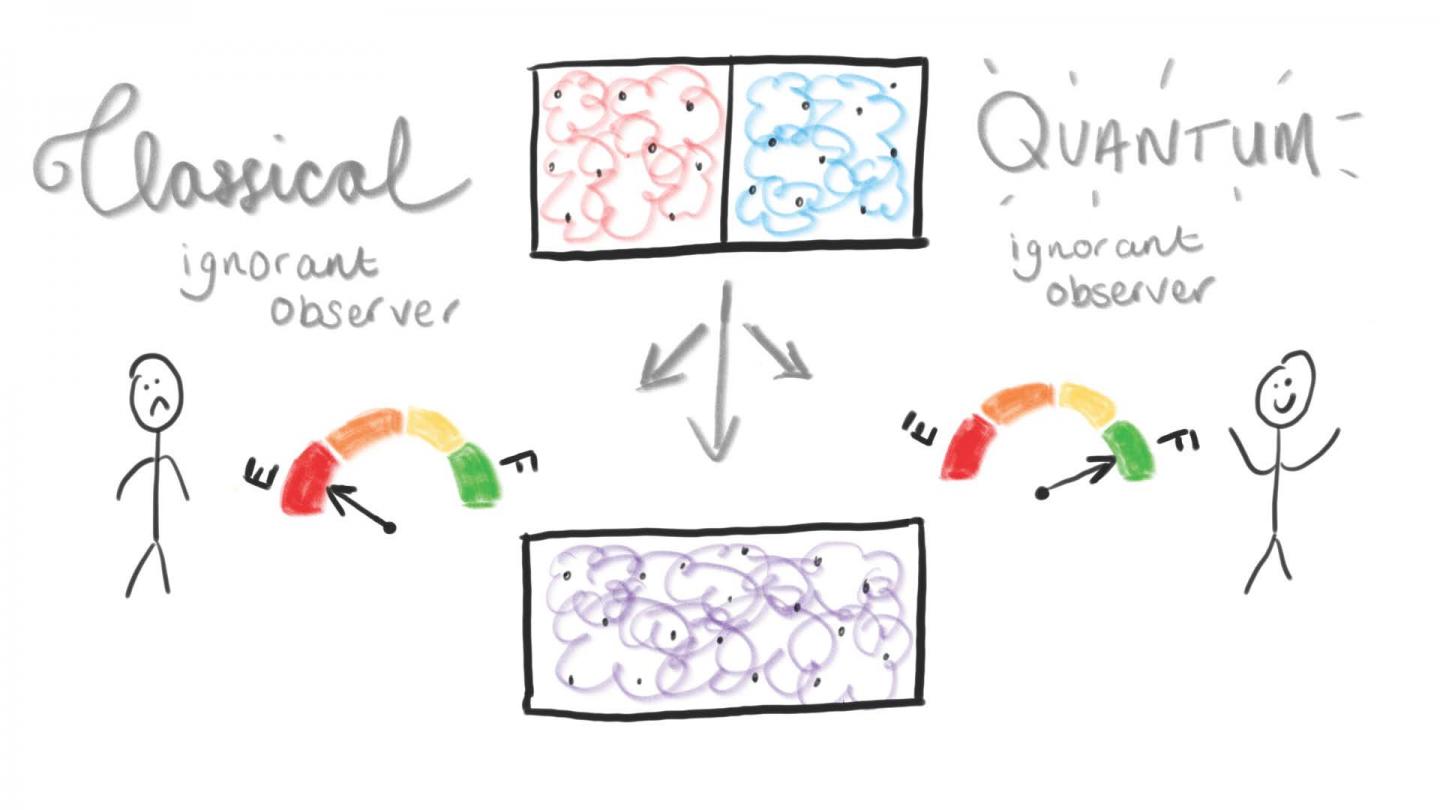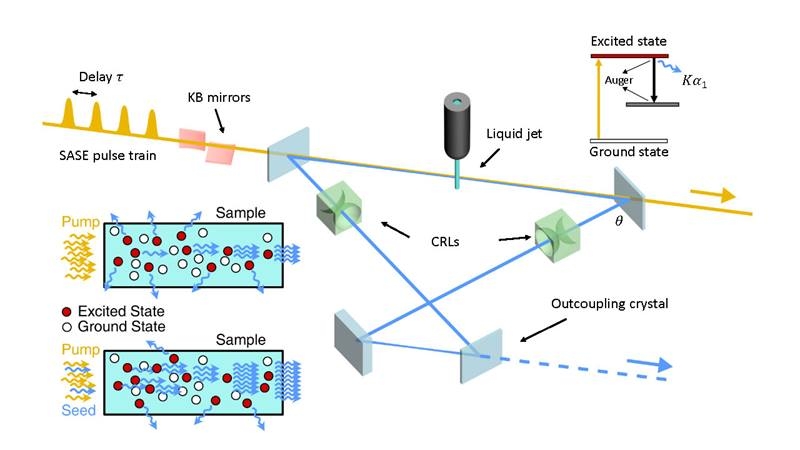New experimental findings cast in doubt 90-year-old theoretical model of the transition state in chemical reactions
Tag: Atomic Physics
Uncovering exotic molecules of potential astrochemical interest
Looking at the night sky, one’s thoughts might be drawn to astrochemistry. What molecules inhabit the vast spaces between the stars? Would we see the same molecules that surround us here on Earth? Or would some of them be more…
New study provides detailed view of how hepatitis B virus establishes chronic infection
The research offers potential strategies for development of new treatments
Laser-driven experiments provide insights into the formation of the universe
Laser-driven experiments conducted on the OMEGA laser at the University of Rochester capture for the first time in a laboratory setting the time history of the growth of magnetic fields by the “turbulent dynamo.”
Moiré than meets the eye
Researchers make carbon nanotube patterns called moirés for materials research
Finding quvigints in a quantum treasure map
Researchers have struck quantum gold–and created a new word–by enlisting machine learning to efficiently navigate a 20-dimensional quantum treasure map. Physicist Dr Markus Rambach from the ARC Centre of Excellence for Engineered Quantum Systems (EQUS) at The University of Queensland…
IceCube detection of a high-energy particle proves 60-year-old theory
The South Pole neutrino detector saw a Glashow resonance event, a phenomenon predicted by Nobel laureate physicist Sheldon Glashow in 1960 where an electron antineutrino and an electron interact to produce a W- boson.
Combined technique using diamond probes for nanoscale imaging of magnetic vortex structure
Magnetometry exploiting color center defects in diamond probes and magneto-optic imaging found to complement each other; progress towards the creation of more effective data storage systems
A liquid crystal walks into an optical resonator: new Skoltech research helps model future optoelect
Researchers at Skoltech and their colleagues proposed a photonic device from two optical resonators with liquid crystals inside them to study optical properties of this system that can be useful for future generations of optoelectronic and spinoptronic devices. The paper…

New quantum theory heats up thermodynamic research
Researchers have developed a new quantum version of a 150-year-old thermodynamical thought experiment that could pave the way for the development of quantum heat engines.
Food security: Irradiation and essential oil vapors for cereal treatment
A combined treatment of irradiation and essential oil vapors could effectively eliminate insects, bacteria and mold in stored grains
New quantum theory heats up thermodynamic research
Researchers have developed a new quantum version of a 150-year-old thermodynamical thought experiment that could pave the way for the development of quantum heat engines. Mathematicians from the University of Nottingham have applied new quantum theory to the Gibbs paradox…
Samara Polytech chemists have predicted more than 200 new carbon allotropes
One of the predicted substances turned out to be harder than a diamond
Performance of methane conversion solid catalyst is predicted by theoretical calculation
Accelerating search for various materials to achieve a carbon-free society
Metallic state of Ag nanoclusters in oxidative dispersion identified in situ
Oxidative dispersion has been widely used in the regeneration of sintered metal catalysts as well as the fabrication of single-atom catalysts. The consensus on the oxidative dispersion process includes the formation of mobile metal oxide species from large metal particles…
Ultra-fast electron measurement provides important findings for the solar industry
Processes in a model system for organic solar cells analyzed at the femtosecond scale for the first time
A beginner’s guide to the basic principles of materials engineering
Fundamentals of Materials Engineering – A Basic Guide is a helpful textbook for readers learning the basics of materials science. This book covers important topics and fundamental concepts of materials engineering including crystal structure, imperfections, mechanical properties of materials, polymers,…
Cockcroft Institute awarded more than £11 million to boost accelerator research
The Cockcroft Institute (CI), a partnership between the Universities of Lancaster, Liverpool, Manchester and Strathclyde, and the Science & Technology Facilities Council (STFC), has been awarded more than £11 million for R&D into accelerator science and technology. The funding, awarded…
Bottling the world’s coldest plasma
Laser-cooled plasma-in-a-bottle could answer questions about the sun, fusion power
Through the looking glass: Artificial ‘molecules’ open door to ultrafast polaritonic devices
Researchers from Skoltech and the University of Cambridge have shown that polaritons, the quirky particles that may end up running the quantum supercomputers of the future, can form structures behaving like molecules – and these “artificial molecules” can potentially be…
Meteorites remember conditions of stellar explosions
Radioactivity in meteorites sheds light on origin of heaviest elements in our solar system
Considering disorder and cooperative effects in photon escape rates from atomic gases
Investigating more complex models of photon escape rates from cold atomic gases could help researchers learn more about light-matter interactions
New insights into the mechanism of nuclear fission
Publication in ‘Nature’ under participation of TU Darmstadt
Scientists probe electronic angular momentum to a chemical reaction for the first time
A chemical reaction can be understood in detail at the quantum state-resolved level, through a combined study of molecular crossed beam experiments and theoretical quantum molecular reaction dynamics simulations. At a single collision condition, the molecular crossed beam apparatus is…
Theory could accelerate push for spintronic devices
Rice University models help ID materials for advanced electronics, computer memories
Twin atoms: A source for entangled particles
Quantum experiments that could previously only be performed with photons are now also possible with atoms: Beams of entangled atoms have been produced at TU Wien (Vienna)
Silver and gold nanowires open the way to better electrochromic devices
A team from INRS developed a new approach for foldable and solid devices
Atomic nuclei in the quantum swing
The extremely precise control of nuclear excitations opens up possibilities of ultra-precise atomic clocks and powerful nuclear batteries
Investigating the wave properties of matter with vibrating molecules
Physics: Publication in Nature Physics
Ultrafast electron dynamics in space and time
“For decades, chemistry has been governed by two ambitions goals,” says Professor Stefan Tautz, head of the Quantum Nanoscience subinstitute at Forschungszentrum Jülich. “One of these is understanding chemical reactions directly from the spatial distribution of electrons in molecules, while…
More sustainable recycling of plastics
Chemists at the University of Konstanz have developed a method for more sustainable recycling of polyethylene-like plastics
A performance leap for Graphene modulators in next generation datacom and telecom
Over the past years, global data traffic has experienced a boom, with over 12.5 billion connected devices all over the world. The current world-wide deployment of the 5G telecommunications standard is triggering the need for smaller devices with enhanced performances,…
Moiré patterns facilitate discovery of novel insulating phases
UC Riverside-led study observed unexpected insulating phases by placing electrons on stacked monolayers of 2D semiconductors
Light used to detect quantum information stored in 100,000 nuclear quantum bits
Researchers have found a way to use light and a single electron to communicate with a cloud of quantum bits and sense their behaviour, making it possible to detect a single quantum bit in a dense cloud. The researchers, from…
Scientists discovered new physical effects important for the ITER reactor operation
Researchers discovered new effects, which affect the energy flow in the reactor
A new quantum switch for electronics
A Russian physicist and his international colleagues studied a quantum point contact (QCP) between two conductors with external oscillating fields applied to the contact. They found that, for some types of contacts, an increase in the oscillation frequency above a…
Quantum causal loops
Causal reasoning is ubiquitous – from physics to medicine, economics and social sciences, as well as in everyday life. Whenever we press the button, the bell rings, and we think that the pressing of the button causes the bell to…
Researchers from NUS create ‘whirling’ nano-structures in anti-ferromagnets
Today’s digital world generates vast amounts of data every second. Hence, there is a need for memory chips that can store more data in less space, as well as the ability to read and write that data faster while using…
Charge radii of exotic potassium isotopes challenge nuclear structure theory
In nuclear physics so-called magic number are such nuclear proton and/or neutron numbers, for which the nucleus is more stable compared to neighboring isotopes on the nuclear chart. Researchers in both experimental and theoretical nuclear physics from University of Jyväskylä,…
“Ghost particle” ML model permits full quantum description of the solvated electron
The behavior of the solvated electron e-aq has fundamental implications for electrochemistry, photochemistry, high-energy chemistry, as well as for biology–its nonequilibrium precursor is responsible for radiation damage to DNA–and it has understandably been the topic of experimental and theoretical investigation…
Solving complex physics problems at lightning speed
A calculation so complex that it takes twenty years to complete on a powerful desktop computer can now be done in one hour on a regular laptop. Physicist Andreas Ekström at Chalmers University of Technology, together with international research colleagues,…
The first steps toward a quantum brain
An intelligent material that learns by physically changing itself, similar to how the human brain works, could be the foundation of a completely new generation of computers. Radboud physicists working toward this so-called “quantum brain” have made an important step.…
A full-scale prototype for muon tomography
Building on previous studies of muon tomography techniques, this topical issue demonstrates a full-scale prototype for the technology, capable of determining the position of a small lead block within a large sensing area
Researchers reveal in-situ manipulation of active Au-TiO2 interface
An international joint research team from the Shanghai Advanced Research Institute of the Chinese Academy of Sciences, along with Zhejiang University and the Technical University of Denmark, reported an in-situ strategy to manipulate interfacial structure with atomic precision during catalytic…
First direct band gap measurements of wide-gap hydrogen using inelastic X-ray scattering
Utilizing a newly developed state-of-the-art synchrotron technique, a group of scientists led by Dr. Ho-kwang Mao, Director of HPSTAR, conducted the first-ever high-pressure study of the electronic band and gap information of solid hydrogen up to 90 GPa. Their innovative…

A Sharp New Eye to View Atoms and Molecules
Physicists long dreamed of producing X-ray laser pulses that probe matter at the level of atoms and molecules. Scientists realized this dream in 2009 with the hard X-ray free-electron laser at the Linac Coherent Light Source (LCLS). But each LCLS X-ray pulse has a slightly different intensity and wavelength distribution. A new oscillator design overcomes these problems with an approach inspired by optical lasers.
White turns into (extreme-)ultraviolet
Researchers from the Max Born Institute for Nonlinear Optics and Short Pulse Spectroscopy (MBI) have developed a new method to modify the spectral width of extreme-ultraviolet (XUV) light. By employing a novel phase-matching scheme in four-wave mixing, they could compress…
Producing green hydrogen through the exposure of nanomaterials to sunlight
A research team from INRS has joined forces with French researchers from ICPEES to pave the way towards the production of green hydrogen
Search for axions from nearby star Betelgeuse comes up empty
Results significantly narrow the range of possible places to find the hypothetical dark matter particles.
Machine-learning models of matter beyond interatomic potentials
Combining electronic structure calculations and machine learning (ML) techniques has become a common approach in the atomistic modelling of matter. Using the two techniques together has allowed researchers, for instance, to create models that use atomic coordinates as the only…